GwinnettForum | Number 21.49 | July 12, 2022
UKRAINIAN AID: Emory Morsberger (right) is shown with two doctors in Ukraine as he hands over $12,000 surgical drills at a hospital in Kyiv. “We all had tears in our eyes,” he says. For more of his mission to deliver hospital supplies in this war-torn country, see Today’s Focus below
TODAY’S FOCUS: Morsberger heard air raid sirens on Ukrainian mission trip
EEB PERSPECTIVE: New book of Gwinnett’s transformation raises at least one question
SPOTLIGHT: Law Office of J. Michael Levengood, LLC
FEEDBACK: Are “widows and orphans” today’s “single moms and their children?”
UPCOMING: GC&B opens application for Green Youth Advisory Council
NOTABLE: Here are ways to enjoy a vacation, while relieving stress
RECOMMENDED New York by Edward Rutherfurd
GEORGIA TIDBIT: Guidestones offer10 principles to ensure humankind’s survival
MYSTERY PHOTO: The tree, the fence, building and big sky: where is it?
LAGNIAPPE: CALENDAR: Historical Society to hear talk July 18 on last slave ship
Morsberger heard air raid sirens on Ukrainian mission trip
(Editor’s Note: this story is pulled from remarks made by Emory Morsberger of Lilburn, who has just returned from delivering medical supplies to Ukraine hospitals. He spent 22 days in that part of the world, primarily working with members of Rotary Clubs in Ukraine. Locally, Morsberger teamed with Chris Brand, president of Friends of Adults and Children (FODAC), and Radu Zernoveanu Jr., a Buckhead Rotarian and native of Romania, to organize aid for the front lines.—eeb)
By Emory Morsberger
ATLANTA, Ga. | First, I want to first of all thank Radu from Buckhead and Chris from Tucker — two of the most amazing partners you could ever ask for.
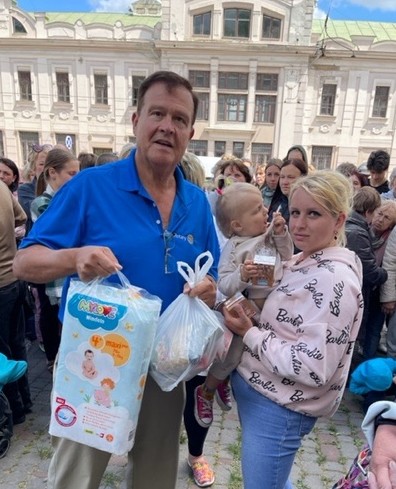
Distributing food and supplies to this mother and her baby, some of the four million “internal refugees,” as the air raid sirens blared.
I came into this project when Chris was finishing the consolidation of 37 pallets (12,000 pounds) of medical equipment in the FODAC warehouse in Tucker. Chris mentioned that they were looking for an escort for the equipment and I immediately volunteered to pay my way and go. I really didn’t quite know what all was going to be happening, but I knew I should go; it was beyond comprehension.
I first flew on Delta to Bucharest, Romania, where I met with numerous Rotarians, who were working to organize shipments for Ukraine. Several hundred Rotarians in Romania have been working to move truckloads of food supplies and medical equipment across the border to Ukraine. There Ukraine Rotarians would distribute them to Northern Ukraine. About the only way to cross the border is with women driving you back and forth.
In Ukraine, I spent a few days helping with food distribution, and meeting a number of the refugees. Most of them were people just like us. I mean, you wouldn’t know them from your average American walking down Peachtree Street. They were disrupted and forced out of their homes, under great pressure, and suddenly ended up in all parts of Ukraine.
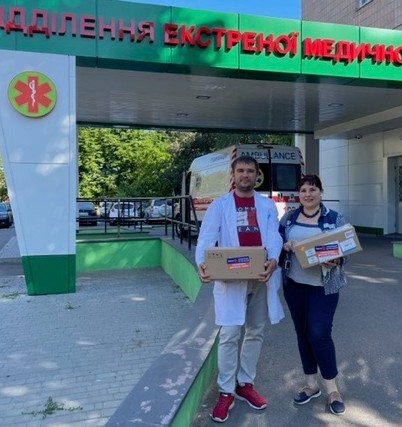
Dr. Olha Paliychuk (aka Ukraine’s Florence Nightingale) delivering some of the Atlanta Area Originated medical supplies to the head of the Cherkasy hospital near the war front.
In Kyiv, I met with a surgeon to give him Stryker Surgical Drills, each worth about $12,000. He looked at those and had tears in his eyes. He was very excited to receive the drills. There were several other surgeons there. They showed me pictures of how bombs basically harm people and what kind of operations they were dealing with.
From there I went to another hospital, basically moving toward the war zone. As we went across this one bridge, my woman driver, Dr. Olha Paliychuk, said, “The Russians keep hitting this bridge, but they haven’t gotten it yet.” And last week they hit the bridge again. You probably saw it on television, but it’s still functional. (It brings tears to my eyes thinking about her. She’s the “Florence Nightingale” of that area.)
Going into her town, I met with other doctors and saw the situation that she’s dealing with.
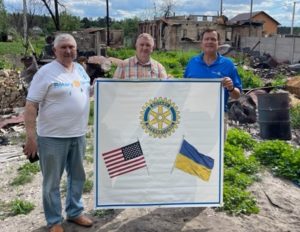
Emory stands with two Ukrainian Rotarians in the center of the devastated community of Moshchun, 20 miles west of Kyiv, with leaders who are planning to rebuild.
From there, we drove to the west side of Ukraine. And I was fortunate to be able to talk to many Rotarians who are leading the 65 Clubs in Ukraine and helping with distribution of all sorts of goods from around the world.
I was in five different Ukrainian towns. In three of those five, I heard air raid sirens while I was there. But I was not scared. I felt like I was meant to be there, was given a mission, and was carrying it out.
The Ukraine Rotarians are coordinating their efforts together beautifully. They’re very organized and committed. They are not giving up. We need to keep sending Ukraine everything we can for that nation to survive and thrive.
We are now working to fund the next shipment of medical equipment to Ukraine. We want to raise money particularly for more surgical drills, and incubators for new born babies. People wishing to contribute can contribute to FODAC at HERE.
- Have a comment? Send to: elliott@brack.net
New book of Gwinnett’s transformation raises one question
By Elliott Brack
Editor and Publisher, GwinnettForum
JULY 12, 2022 | A new book from the University of Georgia Press is entitled Gwinnett County, Georgia, and the transformation of the American South, 1818-2018.
![]() The book is edited by two professors, Michael Gagnon of Flowery Branch, who is an associate professor of history at Georgia Gwinnett College, and Matthew Hild of Atlanta, a lecturer at Georgia Tech.
The book is edited by two professors, Michael Gagnon of Flowery Branch, who is an associate professor of history at Georgia Gwinnett College, and Matthew Hild of Atlanta, a lecturer at Georgia Tech.
The book is a collection of 15 essays by professors and scholars across the South. Five of the authors who write chapters teach at Georgia Gwinnett College.
It’s not a straight-forward history, but an effort by these scholars at explaining why Gwinnett grew and materialized as it did. These scholars go to great lengths in explaining their views on how this happened in Gwinnett. They create voluminous footnotes to detail their versions. While the book is 247 pages in length in what appears to be small type (seven or eight point; it’s hard to read. Of those pages, fully 47 are in footnotes.
A few of the topics included in the 15 chapters (plus nine page of Introduction and a five page Afterward) are:
- Cherokee and Creek Agency in Gwinnett before Button;
- State and Federal Sovereignty: Cherokee Nationalism;
- Slavery and Cotton in Antebellum Gwinnett;
- Reluctant Confederates, etc. and Civil War;
- Reconstruction and Race;
- Air Line Railroads and Town Building;
- Homey Philosophy: Bill Arp;
- Farmers’ Movement and Populism;
- Life of Edward F. “Buck” Buchanan;
- Cotton Culture;
- Alice Harrell Strickland;
- Segregation and Migration;
- Preservation and Modernization;
- Of Malls and MARTA;
- From Burgs to Pueblo: Mass Integration
An interesting introduction by Bradley Rice notes that Gwinnett lacked a significant central identity (such as Decatur or Marietta), and that there has been little explanatory scholarship about the county. And that it didn’t get its first paved road until 1924, so was not so well-connected with Atlanta. That may be a way of saying since its founding in 1818, until after World War II, there wasn’t much happening in Gwinnett.
It was interesting to understand more about Georgia voting to secede from the Union. The three Gwinnett delegates were dead-set against seceding. The Legislature, meeting in Milledgeville, first voted 166-130 to secede, then took a second vote, and that passed 203-89. A third vote (for “unity”) passed with only 10 voting “NO!”, including the three from Gwinnett.
Three chapters seem less intent in explaining why Gwinnett grew as it did. They all focused on individuals, the author Bill Arp, who was born and raised here but gained fame when writing from Rome and Cartersville; Alice Strickland of Duluth, who was the first woman elected to city mayor’s position, but who held this slot for only one year; and Edward F. Buchanan of Norcross, who made millions on Wall Street, but went broke when his company failed. These chapters stand as interesting history, but give little explanation about how the county developed.
One entirely new story emerges. The two editors, Gagnon and Hill, tell us that the Gwinnett Courthouse was torched on Sept. 12, 1871, to destroy evidence against moonshiners. We had never heard who might have set fire to the courthouse, but they say it was led by a “Boney”Allen and four other men. Later the editors identify him as “Bonaparte Allen.” They cite several newspaper accounts about this courthouse fire.
Well now, that raises a question the book does not bring up. Is that the same Bonaparte Allen who went to Buford in the 1870s and started a tannery, which became super successful, then began manufacturing many leather goods, and made the Allen family immensely wealthy? The professors don’t say.
The book is expected to be available for $34.85 starting July 15.
- Have a comment? Send to: elliott@brack.net
Law Office of J. Michael Levengood, LLC
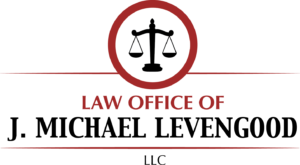 The public spiritedness of our underwriters allows us to bring GwinnettForum.com to you at no cost to readers. Today’s underwriter is the Law Office of J. Michael Levengood, LLC. Before relocating his general civil practice eight years ago to Lawrenceville, Mike Levengood practiced law as a partner in an Atlanta firm for almost 34 years, handling a wide variety of commercial and litigation matters for business clients. Mike is a community leader in Gwinnett County where he serves on several non-profit boards.
The public spiritedness of our underwriters allows us to bring GwinnettForum.com to you at no cost to readers. Today’s underwriter is the Law Office of J. Michael Levengood, LLC. Before relocating his general civil practice eight years ago to Lawrenceville, Mike Levengood practiced law as a partner in an Atlanta firm for almost 34 years, handling a wide variety of commercial and litigation matters for business clients. Mike is a community leader in Gwinnett County where he serves on several non-profit boards.
- Visit this supporter’s web site at https://www.levengoodlaw.com
Are “widows and orphans” today’s “single moms and their children?”
Editor, the Forum:
![]() Wanted to let you know that I appreciate the heart of the letter writer who wrote about the abortion issue with such passion. This letter writer identified an outstanding opportunity. That opportunity is not simply to provide moral and material support for those who find themselves in a crisis pregnancy situation. It is to invest our time, talent, and treasure in serving and lifting up those who need such assistance.
Wanted to let you know that I appreciate the heart of the letter writer who wrote about the abortion issue with such passion. This letter writer identified an outstanding opportunity. That opportunity is not simply to provide moral and material support for those who find themselves in a crisis pregnancy situation. It is to invest our time, talent, and treasure in serving and lifting up those who need such assistance.
Who in the Scriptures are referred to as orphans and widows? It seems that, in the 21st century, single moms and their children are the orphans and widows of our time. My encouragement to all is to find ways to invest time and energy in supporting those who need such support. Not just the pregnant mothers and their unborn children, but the little ones and their parents who need support. Fortunately, Gwinnett County has a number of NGOs committed to just such relief. And the further good news is that there are always opportunities to volunteer one more hour or give one more dollar.
Thank you for this letter.
– Randy Brunson, Duluth
Exempting farm land keeps some counties from growing
Editor, the Forum:
That was a good item on “Taxing real property is not always easy and often not fair.” When I was an elected county commissioner, I headed the Association County Commissioners of Georgia Tax Committee. I tried unsuccessfully to get rid of the “conservation” exemption. That law exempted farmland from local and state property tax. It was used as a tax shelter for wealthy landowners, and keeps many farmed-based counties from growing.
– Jack Bernard, Peachtree City
Story on onions brought back memories of another life
Editor, the Forum:
So good to read Ray Moses’ letter. It brought back lots of memories, as he and I went to the same school. I believe he graduated with one of my younger sisters. My grandfather, Dr. Hiram Chesley Sharpe ,had his medical office in a small room connected to the Post Office in Alston. Ray’s mother, Miss Emily, and my mother were friends. We all went to the same church that my grandfather built. My sisters and I grew up about three miles from downtown Alston so we were considered “country farm kids” and those that grew up in Alston, like Ray, were considered small town country kids.
– Teresa S. Lynn, Duluth
Send us your thoughts: We encourage you to send us your letters and thoughts on issues raised in GwinnettForum. Please limit comments to 300 words, and include your hometown. The views of letters are the opinion of the contributor. We reserve the right to edit for clarity and length. Send feedback and letters to: elliott@brack.net.
GC&B opens application for Green Youth Advisory Council
Gwinnett Clean and Beautiful (GC&B) has opened applications for its youth leadership program, the Green Youth Advisory Council (GYAC) class of 2023.
Applications are now being accepted for the program at the website www.GwinnettCB.org.The Green Youth Advisory Council is a distinctive hands-on opportunity for high school students from diverse backgrounds to participate in an environmental and sustainability service-learning and leadership development program. Participants will contribute to and inform Gwinnett Clean and Beautiful on projects that impact local and global environmental challenges while acting as ambassadors and leaders for youth service in their communities. Applications are due by August 29.
Schelly Marlatt, executive director for GC&B, says “Our involvement with Gwinnett County Public Schools is among the most rewarding aspects of the job for me personally. Witnessing in young students their love of the environment and wanting to make a difference for the greater good is refreshing. If you know someone who fits that description, we’d love for you to recommend that they apply for our Green Youth Advisory Council.”
During the 2021-2022, Green Youth Advisory Council members comprised students from 11 different Gwinnett County high schools .Thanks to the GC&B Jim Steele Environmental Education Scholarship Fund through the Community Foundation of Northeast Georgia, the nonprofit awarded $2,000 scholarships to two of its graduating GYAC members. This year’s scholarship recipients are Logan Zimmerman who will be studying Environmental Science at College of Coastal Georgia and Daniel Jung who will be studying Mathematics/Computer Science at Princeton University.
“Our 2022 class will be a tough act to follow,” adds Marlatt. “They created an awesome ‘Recycling Simplified’ awareness video, participated in many of our community events, brainstormed ideas for potential new programs and initiatives, and so much more. They were a great group of students, and we hope those who didn’t graduate will join us again for GYAC Class of 2023. As always, we’re excited to see what the next crew will bring to the table!”
Here are ways to enjoy a vacation, while relieving stress
The summer season is synonymous with vacationing. People travel all over the world to soak in sunshine and splash in salt water. But what kind of vacations are best to recuperate? Dr. David Ludden, associate professor of psychology at Georgia Gwinnett College, boils down the science.
“People need vacations to de-stress, but not all vacations are created equal,” says Ludden. One type of break he advises against is the “goal-oriented vacation.” Such vacation breaks are filled with one destination or activity after another, with little downtime for relaxation.
“The more relaxed vacation is better for your health. Going somewhere for a few days, sitting back, and taking in some sunshine and scenery do a world of good for your mental wellness.”
Ludden maintains that stress is an important factor in human life. It’s important as a safety measure, but allowing it to fester without treatment can lead to anxiety, insomnia and depression. Vacations are a primary way to work on releasing some of that pent-up stress.
“There’s this scientific philosophy called ‘biophilia’ which explains that humans love and want to be in nature,” Ludden says. “That doesn’t necessarily mean we all want to go live in a jungle, but it does mean that some of the more traditional styles of vacationing, like camping or traveling to state parks, are usually better for people looking to unwind.”
Those options conveniently also limit the campers’ abilities to work in the wilderness, which is something Ludden also points to for people not feeling relaxed after a beach trip. “It’s important to leave the source of stress out of the vacation. Working from the hotel room isn’t a good idea if you’re trying to relax.”
One of the things people do right, however, is involve the whole family. Vacations are an excellent opportunity for families to reaffirm their bonds and relationships, and it doesn’t require a Disney trip every year. Renting a cabin in the mountains or making a day trip to a lake are all healthy and relatively cheap ways to involve the family.
“This isn’t something unique to America,” feels Ludden. “Americans get roughly a third of the average time off than people in European countries. Europeans actually travel more than Americans, and I think a large part of that is because of their average of six weeks off versus our two.” Europeans are able to do those “goal-oriented” trips because they have enough time to be present in the countries or cities for a few days, rather than making a city-by-city trip of one day each.
Ludden concludes: “Americans deserve to unwind. Camping might not be for everyone, but everyone needs something to help them reset and get new perspectives on matters in their lives.”
- Have a comment? Send to: elliott@brack.net
New York, by Edward Rutherfurd
![]() From Susan J. Harris, Stone Mountain: New York by Edward Rutherfurd describes not only the stages of development of this state, but also carves out the personality of the island of Manhattan, where the spirit of New York illuminates the American Dream. The story begins with the settlers of New Amsterdam in 1664 and concludes with the fall of the Twin Towers in 2001. The evolution of New York is played out in the families of Masters, Caruso, Keller, and also the Adlers, Campos and other memorable characters. The epilogue serves to summarize the events in the families and underscores the indomitable spirit of New York and the USA. New York is a most enjoyable and educational read. It will provide the reader with little known facts about the origin of the state and personalizes the energy of this state which is unlike any other. It’s another in a series from the pen of Edward Rutherfurd.
From Susan J. Harris, Stone Mountain: New York by Edward Rutherfurd describes not only the stages of development of this state, but also carves out the personality of the island of Manhattan, where the spirit of New York illuminates the American Dream. The story begins with the settlers of New Amsterdam in 1664 and concludes with the fall of the Twin Towers in 2001. The evolution of New York is played out in the families of Masters, Caruso, Keller, and also the Adlers, Campos and other memorable characters. The epilogue serves to summarize the events in the families and underscores the indomitable spirit of New York and the USA. New York is a most enjoyable and educational read. It will provide the reader with little known facts about the origin of the state and personalizes the energy of this state which is unlike any other. It’s another in a series from the pen of Edward Rutherfurd.
An invitation: what books, restaurants, movies or web sites have you enjoyed recently? Send us your recent selection, along with a short paragraph (150 words) as to why you liked this, plus what you plan to visit or read next. Send to: elliott@brack.net
Guidestones offer 10 principles to ensure human survival
(From previous edition)
(Editor’s note: The Georgia Guidestones were vandalized recently. Here is some detail on them —eeb)
The inscriptions on the Guidestones near Elberton are meant for current and future generations. Sandblasted along the square capstone sitting atop the structure is the basic message: “Let these be guidestones to an age of reason,” in Babylonian cuneiform, Egyptian hieroglyphics, Sanskrit, and classical Greek. The four granite slabs, each weighing 42,137 pounds and standing more than sixteen feet in height, list ten “guides” for mankind in eight different languages. The languages represented on the four major stones are Arabic, Chinese, English, Hebrew, Hindi, Russian, Spanish, and Swahili. The engraved messages can be subdivided into four major areas: governance and the establishment of a world government, population and reproduction control, the environment and humankind’s relationship to nature, and spirituality.
 While some of the “guides” are self-explanatory, others are open to discussion and interpretation. The rich variety of interpretations evoked by the Guidestones has likewise caused much controversy and debate to swirl around the hidden or intended meanings of the messages.
While some of the “guides” are self-explanatory, others are open to discussion and interpretation. The rich variety of interpretations evoked by the Guidestones has likewise caused much controversy and debate to swirl around the hidden or intended meanings of the messages.
According to the Guidestones, the following ten principles are offered to ensure humankind’s future survival:
- Maintain humanity under 500,000,000 in perpetual balance with nature.
- Guide reproduction wisely — improving fitness and diversity.
- Unite humanity with a living new language.
- Rule Passion — Faith — Tradition — and all things with tempered reason.
- Protect people and nations with fair laws and just courts.
- Let all nations rule internally resolving external disputes in a world court.
- Avoid petty laws and useless officials.
- Balance personal rights with social duties.
- Prize truth — beauty — love — seeking harmony with the infinite.
- Be not a cancer on the earth — Leave room for nature — Leave room for nature!
Astronomical phenomena are also associated with the Guidestones. The four large upright granite slabs that compose the face of the structure are oriented to the limits of the moon’s migration during the course of the year. An eye-level, oblique hole is drilled in the Gnomen stone upward toward the celestial heavens and oriented on Polaris, the North Star. In the middle of the Gnomen stone is a large slot with a hole cut through the granite, orienting the monument with summer and winter solstices. The Guidestones also act as an enormous sundial. Drilled through the capstone is a seven-eighths-inch hole, which allows sunlight to shine on the southern face of the Gnomen stone at noon.
The Elberton Granite Museum, in Elberton, offers an impressive display model of the Guidestones as well as a short film detailing its construction. The museum also provides free informational brochures about the Guidestones and their creation.
- To view the Georgia Encyclopedia article online, go to https://www.georgiaencyclopedia.org
The tree, the fence, building and big sky: where is it?
Here’s a distinctive photograph for you to solve. We love the way this photo is dramatically constructed, and perfectly framed. Figure out where this photo was taken and send your answers to elliott@brack.net, and include your hometown.
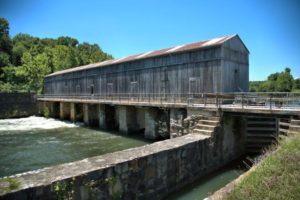 Recognizing the last Mystery Photo was newspaperman Mark Smith of Eatonton. “The picture is the Lock Dam on the canal at the County Park on the Savannah River in Augusta. One of my favorite places. I used to jog there when I was working in Augusta.” The photo came from Brian Brown of Fitzgerald in his Vanishing Georgia series.
Recognizing the last Mystery Photo was newspaperman Mark Smith of Eatonton. “The picture is the Lock Dam on the canal at the County Park on the Savannah River in Augusta. One of my favorite places. I used to jog there when I was working in Augusta.” The photo came from Brian Brown of Fitzgerald in his Vanishing Georgia series.
George Graf of Palmyra, Va. wrote: “This is the Augusta Canal National Historical Canal Headgates, Savannah Rapids Park, Columbia County, Martinez. The power of the water rushing over the rapids helped spark the idea of building a canal that would stretch from the cataract through Augusta and back into the Savannah River. The canal which could be used to turn the wheels of industry.
“Begun in 1845, the first stage of the Augusta Canal was completed the next year. The headgates at today’s Savannah Rapids Park were opened on November 23, 1846, and water flowed for the first time into the canal that had taken 200 men roughly 18 months to build. The canal proved to be a success. Industry began to develop in Augusta, using the slow moving force of the canal to spin turbines creating the power necessary to drive textile and other mills. Thousands of jobs soon resulted from the project.”
Allan Peel of San Antonio, Tex. added: “Henry Harford Cumming (1799–1866) was an important figure in antebellum Augusta and his business was based in the cotton industry. He was the driving force behind the development of the Augusta Canal when he contracted J. Edgar Thomson (1808-1874) to design the Augusta Canal. The Augusta Canal Headgates and the first nine-mile section of the canal were completed between 1845-1846, and within a couple of years three mills had risen along the waterway. During the Civil War, the Confederate Powder Works gunpowder manufacturing complex was built along the canal and many more textile plants and industries followed in the late 19th century. While most southern canals failed to deliver on their builder’s promises, the Augusta Canal was surprisingly successful and is the only intact industrial canal still in use in the South today.”
Others making the connection included Susan McBrayer, Sugar Hill; and Lou Camiero of Lilburn.
Historical Society to hear talk July 18 on last slave ship
A Lawrenceville native will speak on Monday, July 18, at 7 p.m. at the Gwinnett Historical Society on the second floor of the Gwinnett Historic Courthouse. Tyler Bagwell will discuss “The last slave ship to land in Georgia.” He is an associate professor of communication at the College of Coastal Georgia. He has authored two books and numerous journal articles on the subject. In 2019 Bagwell won three Telly Awards and was nominated for two Southeastern Emmys for a public television special he produced about the Wanderer slave ship.
GwinnettForum is provided to you at no charge every Tuesday and Friday.
Meet our team
- Editor and publisher: Elliott Brack, 770-840-1003
- Managing editor: Betsy Brack
- Roving photographer: Frank Sharp
- Contributing columnist: Jack Bernard
- Contributing columnist: George Wilson
More
- Mailing address: P.O. Box 1365, Norcross, Ga. 30091
- Work with us: If you would like to learn about how to be an underwriter to support the publication of GwinnettForum as a community resource for news and commentary, please contact us today.
Subscriptions to GwinnettForum are free.
- Click to subscribe.
- Unsubscribe. We hope you’ll keep receiving the great news and information from GwinnettForum, but if you need to unsubscribe, go to this page and unsubscribe in the appropriate box.
© 2022, Gwinnett Forum.com. Gwinnett Forum is an online community commentary for exploring pragmatic and sensible social, political and economic approaches to improve life in Gwinnett County, Ga. USA.


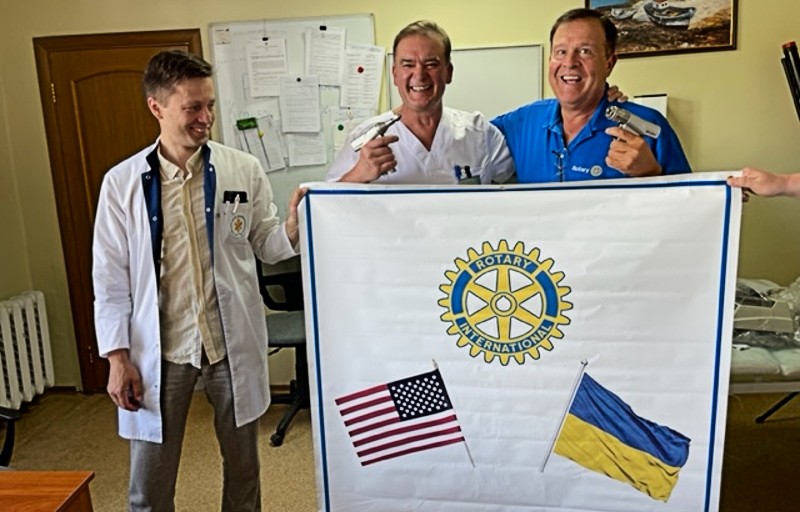
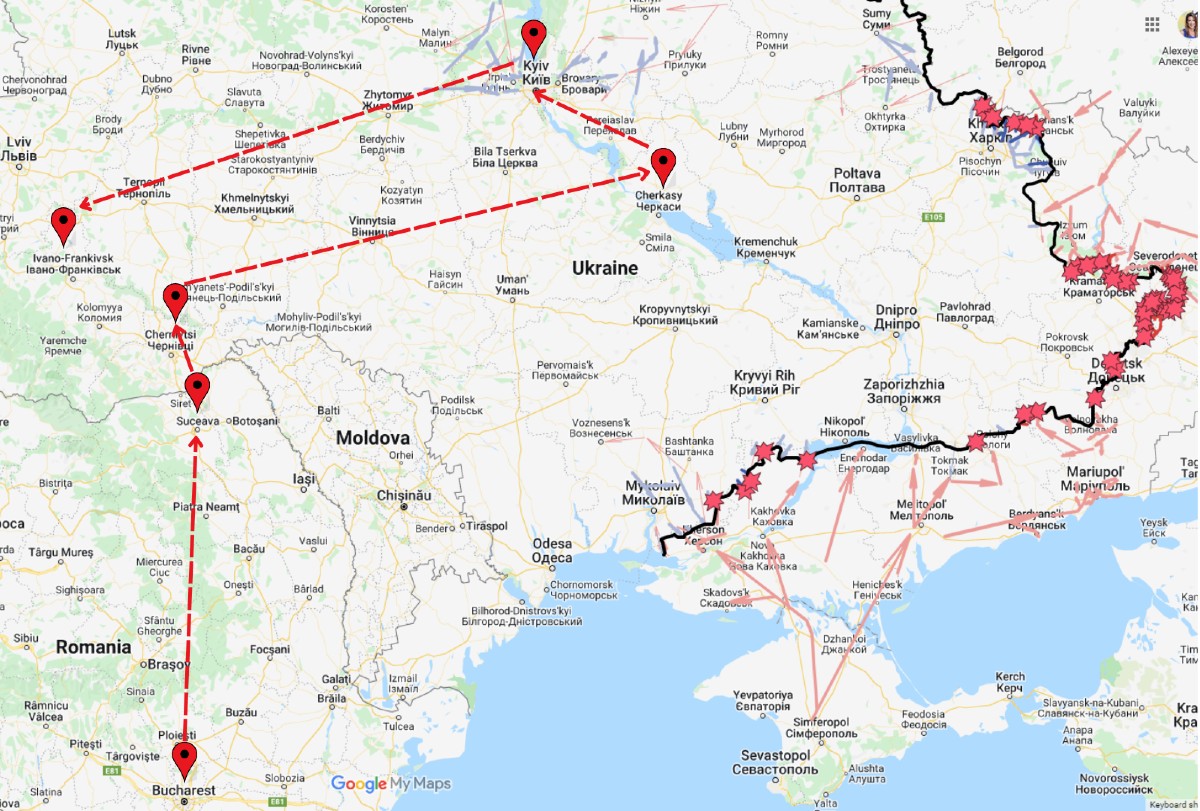
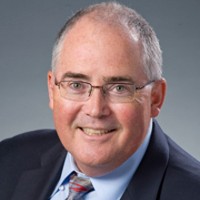
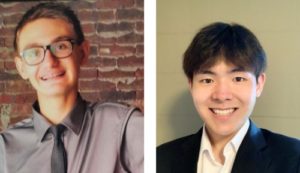
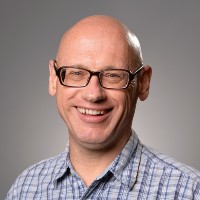
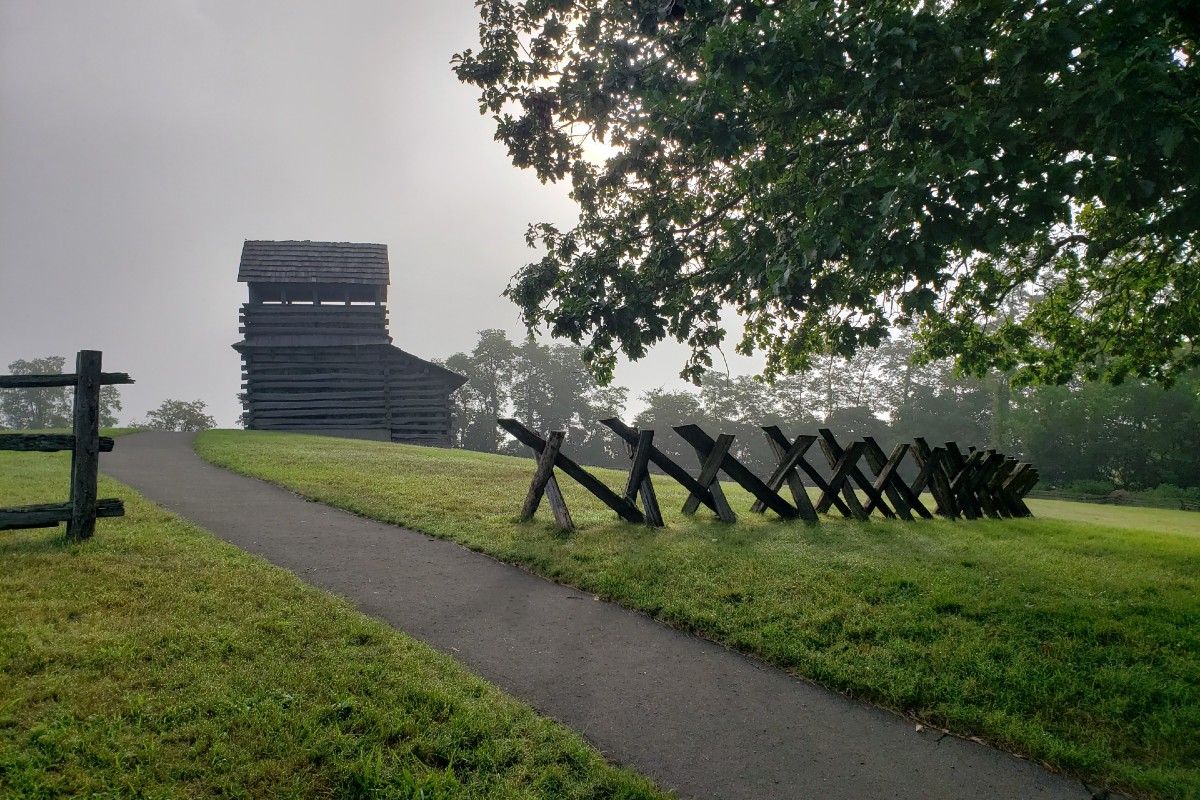
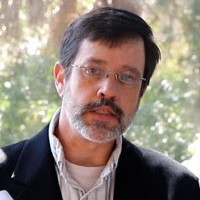







Follow Us